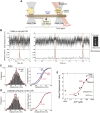Step Sizes and Rate Constants of Single-headed Cytoplasmic Dynein Measured with Optical Tweezers
- PMID: 30397249
- PMCID: PMC6218510
- DOI: 10.1038/s41598-018-34549-7
Step Sizes and Rate Constants of Single-headed Cytoplasmic Dynein Measured with Optical Tweezers
Abstract
A power stroke of dynein is thought to be responsible for the stepping of dimeric dynein. However, the actual size of the displacement driven by a power stroke has not been directly measured. Here, the displacements of single-headed cytoplasmic dynein were measured by optical tweezers. The mean displacement of dynein interacting with microtubule was ~8 nm at 100 µM ATP, and decreased sigmoidally with a decrease in the ATP concentration. The ATP dependence of the mean displacement was explained by a model that some dynein molecules bind to microtubule in pre-stroke conformation and generate 8-nm displacement, while others bind in the post-stroke one and detach without producing a power stroke. Biochemical assays showed that the binding affinity of the post-stroke dynein to a microtubule was ~5 times higher than that of pre-stroke dynein, and the dissociation rate was ~4 times lower. Taking account of these rates, we conclude that the displacement driven by a power stroke is 8.3 nm. A working model of dimeric dynein driven by the 8-nm power stroke was proposed.
Conflict of interest statement
The authors declare no competing interests.
Figures






Similar articles
-
The regulatory function of the AAA4 ATPase domain of cytoplasmic dynein.Nat Commun. 2020 Nov 23;11(1):5952. doi: 10.1038/s41467-020-19477-3. Nat Commun. 2020. PMID: 33230227 Free PMC article.
-
Modeling of Chemomechanical Coupling of Cytoplasmic Dynein Motors.J Phys Chem B. 2024 Oct 17;128(41):10063-10074. doi: 10.1021/acs.jpcb.4c04554. Epub 2024 Oct 9. J Phys Chem B. 2024. PMID: 39382058
-
Probing the force generation and stepping behavior of cytoplasmic Dynein.Methods Mol Biol. 2011;783:63-80. doi: 10.1007/978-1-61779-282-3_4. Methods Mol Biol. 2011. PMID: 21909883
-
Molecular organization and force-generating mechanism of dynein.FEBS J. 2011 Sep;278(17):2964-79. doi: 10.1111/j.1742-4658.2011.08253.x. Epub 2011 Aug 8. FEBS J. 2011. PMID: 21777385 Review.
-
[Structure and mechanism of cytoplasmic dynein].Seikagaku. 2013 Apr;85(4):272-5. Seikagaku. 2013. PMID: 23717874 Review. Japanese. No abstract available.
Cited by
-
Self-organized networks: Darwinian evolution of dynein rings, stalks, and stalk heads.Proc Natl Acad Sci U S A. 2020 Apr 7;117(14):7799-7802. doi: 10.1073/pnas.1920840117. Epub 2020 Mar 23. Proc Natl Acad Sci U S A. 2020. PMID: 32205434 Free PMC article.
-
Oscillatory movement of a dynein-microtubule complex crosslinked with DNA origami.Elife. 2022 Jun 24;11:e76357. doi: 10.7554/eLife.76357. Elife. 2022. PMID: 35749159 Free PMC article.
-
Heterogeneous dissociation process of truncated RNAs by oligomerized Vasa helicase.Commun Biol. 2021 Dec 10;4(1):1386. doi: 10.1038/s42003-021-02918-0. Commun Biol. 2021. PMID: 34893756 Free PMC article.
-
Versatile properties of dynein molecules underlying regulation in flagellar oscillation.Sci Rep. 2023 Jun 29;13(1):10514. doi: 10.1038/s41598-023-37242-6. Sci Rep. 2023. PMID: 37386019 Free PMC article.
-
Flagellar energy costs across the tree of life.Elife. 2022 Jul 26;11:e77266. doi: 10.7554/eLife.77266. Elife. 2022. PMID: 35881430 Free PMC article.
References
Publication types
MeSH terms
Substances
LinkOut - more resources
Full Text Sources

